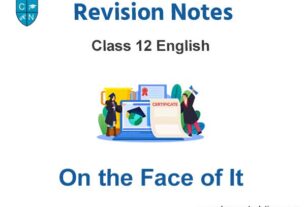Please refer to Locomotion and Movement Class 11 Biology notes and questions with solutions below. These revision notes and important examination questions have been prepared based on the latest Biology books for Class 11. You can go through the questions and solutions below which will help you to get better marks in your examinations.
Class 11 Biology Locomotion and Movement Notes and Questions
Points To Remember
Arthritis :an inflammatory joint disease characterised by inflammation of joints.
Coccyx : tail bone formed by fusion of four coccygeal vertebrae in man. Dicondylic Skull : A Skull with two occipital condyles.
Endo Skeleton : A skeleton present in side the body.
Fascicle : Bundles of muscles fibres held together by connective tissue. Fascia :Collagenous connective tissue layer that surrounds muscle bundles. Floating ribs : The ribs that remain free anteriorly, (last 2 pairs)
False ribs : 8th, 9th and 1Oth pair of ribs not directly joins the sternum but to seventh pair of ribs, hence called pseudoribs.
Myoglobin : A red colored pigment present in sarcoplasm of muscle. Sarcomere : A portion of myofibril between two successive ‘Z’ lines. Sarcocolema : The plasma membrane of a muscle.
Gout : Inflammation of joints due to accumulation of uric acid crystal.
Suture: immovable joints between skull bones.
Synovial joints : Freely movable joints between limb bones. Patella : A seasmoid bone acting as kneecap.
Intervertebral disc : Fibrocartilaginous pad present between the vertebrae that act as shock absorbers.
Tendon- Connective tissue made of yellow fibrous tissue which connect muscle to bone. It is not flexible.
Ligament- Connective tissue made of white fibrous tissue which joins two bones. It is flexible.
L.M.M. : Light meromyosin
HMM : Heavy meromyosin
Types of Movement :
- Amoeboid movement : These movements takes place in phagocytes where leucocytes and macrophages migrate through tissue. It is affected by pseudepodia formed by the streaming of protoplasm (as in amoeba)
- Ciliary movement: These movement occurs in internal organs which are lined by ciliary epithelium.
- Muscular Movement : This movements involve the muscle fibers, which have the ability to contract and relex.
Properties ofMuscle:
(i) Excitability (ii) Contractility
(iii) Extensibility (iv) Elasticity
Types of Muscles:
(a) Skeletal muscles or striated muscles – These involved in locomotion and change of body postures. These are also known as voluntary muscles.
(b) Visceral muscles or smooth muscles – These are located in inner wall of hollow visceral organ, smooth in appearance and their activity are not under control of voluntary nervous system. They are called involuntary muscles.
(c) Cardiac muscles – The muscles ofheart, involuntary in nature, striated and branched, These are uninucleated.

Structure of myofibril :
- Each myofibril consist of alternate dark and light band.
- Dark band-contain myosin protein and is called A-band or Anisotroic band.
- Light band-Contain actin protein and is called I Band or Isotropic band.
- I Band is bisected by an elastic fiber called ‘Z’ line. Actin filament (thin filament) are firmly attached to the ‘Z’ lines.
- Myosin filament (thick filament) in the ‘A’ Band are also held together in the middle ofT Band by thin fibrous membrane called ‘M’ line.
- The portion between two successive ‘Z’ lines is considered as functional unit of contraction and is called a sarcomere.
Structure of Actin and Myosin Filament

- Actin filament : An actin filament is made of two ‘F’ actins which are helically wound to each other. Two filaments of tropo myosin protein also run close to ‘F’ actins throughout its length. A complex protein Troponin is distributed at regular intervals on tropomyosin which mask the actin binding site for myosin.
- Myosin filament : Each myosin filament is a polymer of meromyosin. Each meromyosin has two components- a globular head with a short arm and a tail. Head is made of heavy meromyosin while tail is made of light meromyosin. The head with its short arm project outward at regular distance and angle from each other and is known as cross arm. The head has an active site for actin and binding site for ATP.
Red muscle fibres :
— These are red in colour due to presence of high content of myoglobin.
— These contain plenty of mitochondria.
— Sarcoplasmic reticulum is less in these fibres.
— Show slow but sustained contractions for longer periods.
White muscle fibres
— These are pale or whitish due to presence of less content of myoglobin. These contain fewer mitochondria
— Sarcoplasmic reticulum is more/high
— During strenuous exercise, lactic acid accumulates in large quantity so muscle fatigues
Mechanism or Muscle contraction : Sliding filament theory
The contraction of muscle fiber takes place by the sliding of actin (thin filament) on myosin (thick filament)
- Muscle contraction is initiated by a signal sent by the CNS via a motor neuron.
- Impulse from motor nerve stimulates a muscle fiber at neuro muscular junctions.
- Neurotransmitter releases here which generates an action potential m sarcolema.
- This causes release of Ca++ into sarcoplasm. These Ca++ binds with troponin, thereby remove masking of active site.
- Myosin head binds to exposed active site on actin to form a cross bridge, utilising energy from ATP hydrolysis.
- This pulls the acin filament towards the centre of ‘A: band.
- ‘Z’ lines also pulled inward thereby causing a shortening of sarcomere i.e. contraction.
- I band get reduced, whereas the ‘A: band retain the length.
- During relexation, the cross bridge between the actin and myosin break. Ca++ pumped back to sarcoplasmic cisternae. Actin filament slide out of’A band and length of I band increase. This returns the muscle to its original state.
Vertebral formulae of man C7T12L5S(5)C(4)= 33


We hope the above Locomotion and Movement Class 11 Biology are useful for you. If you have any questions then post them in the comments section below. Our teachers will provide you an answer. Also refer to MCQ Questions for Class 11 Biology


